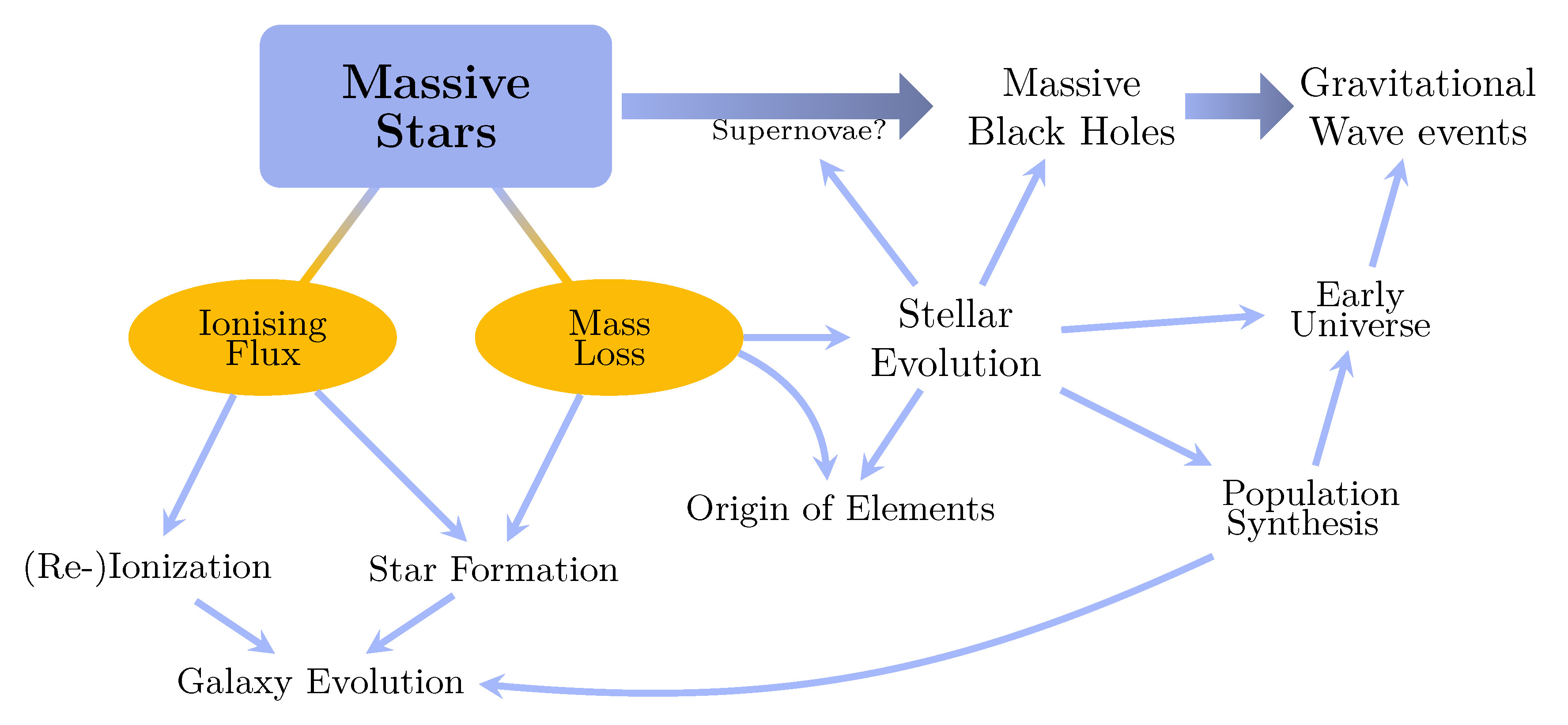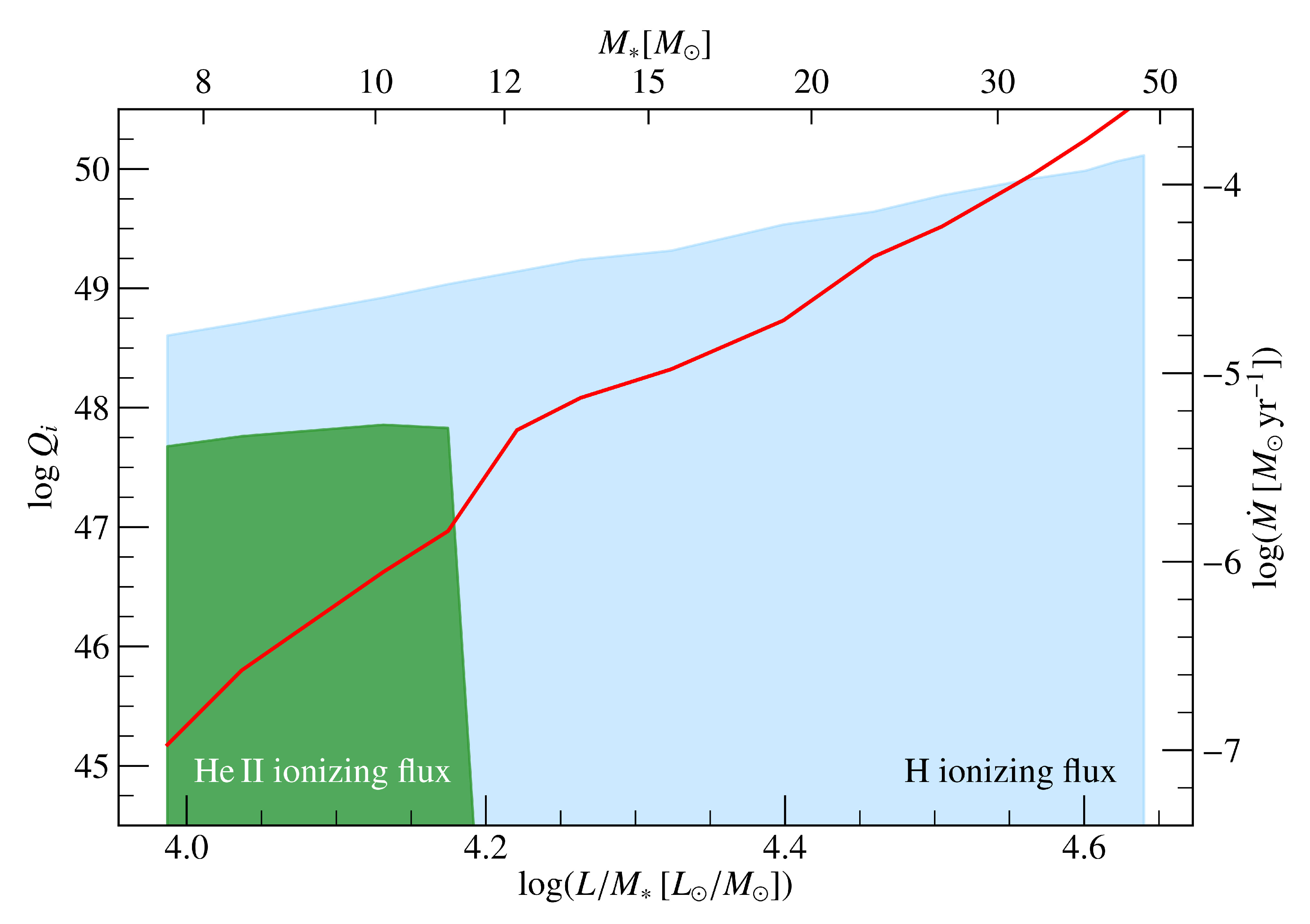Star Formation in the Ultraviolet
Abstract
1. Introduction
- Overview: Star Formation in the Ultraviolet—Jorick S. Vink
- The UV Perspective of Low-Mass Star Formation—Schneider, Günther & France
- On the mass accretion rates of Herbig Ae/Be stars—Ignacio Mendigutia
- UV Spectroscopy of massive stars—John Hillier
- Massive Star Formation in the Ultraviolet observed with HST—Claus Leitherer
- Applications of Stellar Population Synthesis in the Distant Universe—Elizabeth Stanway
2. T Tauri and Herbig Ae/Be Stars
3. Massive and Very Massive Stars
4. WR Stars
5. He II Emission at High Redshift
6. Stripped Stars Due to Potential Binary Interaction
7. Summary and Outlook
Funding
Acknowledgments
Conflicts of Interest
References
- Abel, T.; Bryan, G.L.; Norman, M.L. The Formation and Fragmentation of Primordial Molecular Clouds. Astrophys. J. 2000, 540, 39. [Google Scholar] [CrossRef]
- Bromm, V.; Coppi, P.S.; Larson, R.B. Forming the First Stars in the Universe: The Fragmentation of Primordial Gas. Astrophys. J. 1999, 527, L5. [Google Scholar] [CrossRef] [PubMed]
- Sana, H.; de Koter, A.; de Mink, S.E.; Dunstall, P.R.; Evans, C.J.; Hénault-Brunet, V.; Maíz Apellániz, J.; Ramírez-Agudelo, O.H.; Taylor, W.D.; Walborn, N.R.; et al. The VLT-FLAMES Tarantula Survey. VIII. Multiplicity properties of the O-type star population. Astronom. Astrophys. 2013, 550, A107. [Google Scholar] [CrossRef]
- Hartmann, L.; Herczeg, G.; Calvet, N. Accretion onto Pre-Main-Sequence Stars. Annu. Rev. Astronom. Astrophys. 2016, 54, 135. [Google Scholar] [CrossRef]
- Calvet, N.; Gullbring, E. The Structure and Emission of the Accretion Shock in T Tauri Stars. Astrophys. J. 1998, 509, 802. [Google Scholar] [CrossRef]
- De Marchi, G.; Panagia, N.; Romaniello, M.; Sabbi, E.; Sirianni, M.; Moroni, P.G.P.; Degl’Innocenti, S. Photometric Determination of the Mass Accretion Rates of Pre-main-sequence Stars. II. NGC 346 in the Small Magellanic Cloud. Astrophys. J. 2011, 740, 11. [Google Scholar] [CrossRef]
- Kalari, V.M.; Vink, J.S. Pre-main-sequence Accretion in the Low Metallicity Galactic Star-forming Region Sh 2-284. Astrophys. J. 2015, 800, 113. [Google Scholar] [CrossRef][Green Version]
- Schneider, F.R.N.; Sana, H.; Evans, C.J.; Bestenlehner, J.M.; Castro, N.; Fossati, L.; Gräfener, G.; Langer, N.; Ramírez-Agudelo, O.H.; Sabín-Sanjulián, C.; et al. An excess of massive stars in the local 30 Doradus starburst. Science 2018, 359, 69–71. [Google Scholar] [CrossRef]
- Haemmerlé, L.; Mayer, L.; Klessen, R.S.; Hosokawa, T.; Madau, P.; Bromm, V. Formation of the first stars and black holes. arXiv 2020, arXiv:2003.10533. [Google Scholar]
- Mokiem, M.R.; de Koter, A.; Vink, J.S.; Puls, J.; Evans, C.J.; Smartt, S.J.; Crowther, P.A.; Herrero, A.; Langer, N.; Lennon, D.J.; et al. The empirical metallicity dependence of the mass-loss rate of O- and early B-type stars. Astronom. Astrophys. 2007, 473, 603–614. [Google Scholar] [CrossRef]
- Bouret, J.-C.; Lanz, T.; Hillier, D.J.; Martins, F.; Marcolino, W.L.F.; Depagne, E. No breakdown of the radiatively driven wind theory in low-metallicity environments. Mon. Notices R. Astronom. Soc. 2015, 449, 1545. [Google Scholar] [CrossRef]
- Tramper, F.; Straal, S.M.; Sanyal, D.; Sana, H.; de Koter, A.; Gräfener, G.; Langer, N.; Vink, J.S.; De Mink, S.E.; Kaper, L. Massive stars on the verge of exploding: The properties of oxygen sequenceWolf-Rayet stars. Astronom. Astrophys. 2015, 581, A110. [Google Scholar] [CrossRef]
- Evans, C.J.; Castro, N.; Gonzalez, O.A.; Garcia, M.; Bastian, N.; Cioni, M.-R.L.; Clark, J.S.; Davies, B.; Ferguson, A.M.N.; Kamann, S.; et al. First stellar spectroscopy in Leo P. Astronom. Astrophys. 2019, 622, A129. [Google Scholar]
- Garcia, M.; Herrero, A.; Najarro, F.; Camacho, I.; Lorenzo, M. Ongoing star formation at the outskirts of Sextans A: Spectroscopic detection of early O-type stars. Mon. Notices R. Astonom. Soc. 2019, 484, 422. [Google Scholar] [CrossRef]
- Ramachandran, V.; Hamann, W.R.; Oskinova, L.M.; Gallagher, J.S.; Hainich, R.; Shenar, T.; Sander, A.A.C.; Todt, H.; Fulmer, L. Testing massive star evolution, star formation history, and feedback at low metallicity. Spectroscopic analysis of OB stars in the SMC Wing. Astronom. Astrophys. 2019, 625, A104. [Google Scholar] [CrossRef]
- Beals, C.S. On the Physical Characteristics of the Wolf Rayet Stars and their Relation to Other Objects of Early Type (with Plates VIII, IX). J. R. Astronom. Soc. Can. 1940, 34, 169. [Google Scholar]
- Shenar, T.; Gilkis, A.; Vink, J.S.; Sana, H.; Sander, A.A.C. Why binary interaction does not necessarily dominate the formation of Wolf-Rayet stars at low metallicity. Astronom. Astrophys. 2020, 634, A79. [Google Scholar] [CrossRef]
- Vink, J.S.; Gräfener, G. The Transition Mass-loss Rate: Calibrating the Role of Line-driven Winds in Massive Star Evolution. Astrophys. J. 2012, 751, L34. [Google Scholar] [CrossRef]
- Castor, J.I.; Abbott, D.C.; Klein, R.I. Radiation-driven winds in Of stars. Astrophys. J. 1975, 195, 157. [Google Scholar] [CrossRef]
- Sander, A.A.C.; Vink, J.S.; Hamann, W.-R. Driving classical Wolf-Rayet winds: A Γ- and Z-dependent mass-loss. Mon. Notices R. Astonom. Soc. 2020, 491, 4406. [Google Scholar] [CrossRef]
- Vink, J.S.; Muijres, L.E.; Anthonisse, B.; de Koter, A.; Gräfener, G.; Langer, N. Wind modelling of very massive stars up to 300 solar masses. Astronom. Astrophys. 2011, 531, A132. [Google Scholar] [CrossRef]
- Bestenlehner, J.M.; Gräfener, G.; Vink, J.S.; Najarro, F.; de Koter, A.; Sana, H.; Evans, C.J.; Crowther, P.A.; Hénault-Brunet, V.; Herrero, A.; et al. The VLT-FLAMES Tarantula Survey. XVII. Physical and wind properties of massive stars at the top of the main sequence. Astronom. Astrophys. 2014, 570, A38. [Google Scholar] [CrossRef]
- Crowther, P.A.; Caballero-Nieves, S.M.; Bostroem, K.A.; Apellániz, J.M.; Schneider, F.R.N.; Walborn, N.R.; Angus, C.R.; Brott, I.; Bonanos, A.; de Koter, A.; et al. The R136 star cluster dissected with Hubble Space Telescope/STIS. I. Far-ultraviolet spectroscopic census and the origin of He II l1640 in young star clusters. Mon. Notices R. Astonom. Soc. 2016, 458, 624–659. [Google Scholar] [CrossRef]
- Bestenlehner, J.M. The R136 star cluster dissected with Hubble Space Telescope/STIS. II. Physical properties of the most massive stars in R136. Mon. Notices R. Astonom. Soc. 2020. in preparation. [Google Scholar]
- Doran, E.I.; Crowther, P.A.; de Koter, A.; Evans, C.J.; McEvoy, C.; Walborn, N.R.; Bastian, N.; Bestenlehner, J.M.; Gräfener, G.; Herrero, A.; et al. The VLT-FLAMES Tarantula Survey. XI. A census of the hot luminous stars and their feedback in 30 Doradus. Astronom. Astrophys. 2013, 558, A134. [Google Scholar] [CrossRef]
- Weidner, C.; Kroupa, P. Evidence for a fundamental stellar upper mass limit from clustered star formation. Mon. Notices R. Astonom. Soc. 2004, 348, 187. [Google Scholar] [CrossRef]
- Oey, M.S.; Clarke, C.J. Statistical Confirmation of a Stellar Upper Mass Limit. Astrophys. J. 2005, 620, L43. [Google Scholar] [CrossRef]
- Figer, D.F. An upper limit to the masses of stars. Nature 2005, 434, 192. [Google Scholar] [CrossRef]
- Voss, R.; Diehl, R.; Hartmann, D.H.; Cervino, M.; Vink, J.S.; Meynet, G.; Limongi, M.; Chieffi, A. Using population synthesis of massive stars to study the interstellar medium near OB associations. Astronom. Astrophys. 2009, 504, 531–542. [Google Scholar] [CrossRef]
- Crowther, P.A.; Schnurr, O.; Hirschi, R.; Yusof, N.; Parker, R.J.; Goodwin, S.P.; Kassim, H.A. The R136 star cluster hosts several stars whose individual masses greatly exceed the accepted 150Msolar stellar mass limit. Mon. Notices R. Astonom. Soc. 2010, 408, 731–751. [Google Scholar] [CrossRef]
- Martins, F. Empirical Properties of Very Massive Stars. In Very Massive Stars in the Local Universe; Springer: Cham, Switzerland, 2015. [Google Scholar]
- Vink, J.S. Very massive stars: A metallicity-dependent upper-mass limit, slow winds, and the self-enrichment of globular clusters. Astronom. Astrophys. 2018, 615, A119. [Google Scholar] [CrossRef]
- Schaerer, D. The transition from Population III to normal galaxies: Lyalpha and He II emission and the ionising properties of high redshift starburst galaxies. Astronom. Astrophys. 2003, 397, 527. [Google Scholar] [CrossRef]
- Shapley, A.E.; Steidel, C.C.; Pettini, M.; Adelberger, K.L. Rest-Frame Ultraviolet Spectra of z~3 Lyman Break Galaxies. Astrophys. J. 2003, 588, 65. [Google Scholar] [CrossRef]
- Eldridge, J.J.; Stanway, E.R. The effect of stellar evolution uncertainties on the rest-frame ultraviolet stellar lines of C IV and He II in high-redshift Lyman-break galaxies. Mon. Notices R. Astonom. Soc. 2012, 419, 479. [Google Scholar] [CrossRef]
- Steidel, C.C.; Strom, A.L.; Pettini, M.; Rudie, G.C.; Reddy, N.A.; Trainor, R.F. Reconciling the Stellar and Nebular Spectra of High-redshift Galaxies. Astrophys. J. 2016, 826, 159. [Google Scholar] [CrossRef]
- Cassata, P.; Le Fèvre1, O.; Charlot, S.; Contini, T.; Cucciati, O.; Garilli, B.; Zamorani, G.; Adami1, C.; Bardelli, S.; Le Brun, V.; et al. He II emitters in the VIMOS VLT Deep Survey: Population III star formation or peculiar stellar populations in galaxies at z = 2 − 4.6. Astronom. Astrophys. 2013, 556, A68. [Google Scholar] [CrossRef]
- Sobral, D.; Matthee, J.; Darvish, B.; Schaerer, D.; Mobasher, B.; Röttgering, H.J.A.; Santos, S.; Hemmati, S. Evidence for PopIII-like Stellar Populations in the Most Luminous Lyman-a Emitters at the Epoch of Reionization: Spectroscopic Confirmation. Astrophys. J. 2015, 808, 139. [Google Scholar] [CrossRef]
- Gräfener, G.; Vink, J.S. Narrow He II emission in star-forming galaxies at low metallicity. Stellar wind emission from a population of very massive stars. Astronom. Astrophys. 2015, 578, L2. [Google Scholar] [CrossRef]
- Leitherer, C.; Schaerer, D.; Goldader, J.D.; Delgado, R.M.G.; Robert, C.; Kune, D.F.; de Mello, D.F.; Devost, D.; Heckman, T.M. Starburst99: Synthesis Models for Galaxies with Active Star Formation. Astrophys. J. 1999, 123, 3. [Google Scholar] [CrossRef]
- Leitherer, C. Massive Star Formation in the Ultraviolet Observed with the Hubble Space Telescope. Galaxies 2020, 8, 13. [Google Scholar] [CrossRef]
- Kehrig, C.; Vílchez, J.M.; Pérez-Montero, E.; Iglesias-Páramo, J.; Brinchmann, J.; Kunth, D.; Durret, F.; Bayo, F.M. The Extended He II l4686-emitting Region in IZw 18 Unveiled: Clues for Peculiar Ionizing Sources. Astrophys. J. 2015, 801, L28. [Google Scholar] [CrossRef]
- Senchyna, P.; Stark, D.P.; Vidal-García, A.; Chevallard, J.; Charlot, S.; Mainali, R.; Jones, T.; Wofford, A.; Feltre, A.; Gutkin, J. Ultraviolet spectra of extreme nearby star-forming regions—Approaching a local reference sample for JWST. Mon. Notices R. Astonom. Soc. 2017, 472, 2608–2632. [Google Scholar] [CrossRef]
- Jaskot, A.E.; Oey, M.S.; Scarlata, C.; Dowd, T. Kinematics and Optical Depth in the Green Peas: Suppressed Superwinds in Candidate LyC Emitters. Astrophys. J. 2017, 851, L9. [Google Scholar] [CrossRef]
- Berg, D.A.; Erb, D.K.; Auger, M.W.; Pettini, M.; Brammer, G.B. A Widow on the Earliest Star Formation: Extreme Photoionization Conditions of a High-ionization, Low-metallicity Lensed Galaxy at z = 2. Astrophys. J. 2018, 859, 164. [Google Scholar] [CrossRef]
- Erb, D.K.; Berg, D.A.; Auger, M.W.; Kaplan, D.L.; Brammer, G.; Pettini, M. Subkiloparsec Imaging of Lyα Emission in a Low-mass, Highly Ionized, Gravitationally Lensed Galaxy at z = 1.84. Astrophys. J. 2019, 884, 7. [Google Scholar] [CrossRef]
- Götberg, Y.; de Mink, S.E.; McQuinn, M.; Zapartas, E.; Groh, J.H.; Norman, C. Contribution from stars stripped in binaries to cosmic reionization of hydrogen and helium. Astronom. Astrophys. 2020, 634, A134. [Google Scholar] [CrossRef]
- Stanway, E.R.; Eldridge, J.J.; Becker, G.D. Stellar population effects on the inferred photon density at reionization. Mon. Notices R. Astonom. Soc. 2016, 456, 485. [Google Scholar] [CrossRef]
- Nugis, T.; Lamers, H.J.G.L.M. Mass-loss rates of Wolf-Rayet stars as a function of stellar parameters. Astronom. Astrophys. 2000, 360, 227. [Google Scholar]
- Vink, J.S. Winds from stripped low-mass helium stars and Wolf-Rayet stars. Astronom. Astrophys. 2017, 607, L8. [Google Scholar] [CrossRef]
- Stanway, E.R. Applications of Stellar Population Synthesis in the Distant Universe. Galaxies 2020, 8, 6. [Google Scholar] [CrossRef]





© 2020 by the author. Licensee MDPI, Basel, Switzerland. This article is an open access article distributed under the terms and conditions of the Creative Commons Attribution (CC BY) license (http://creativecommons.org/licenses/by/4.0/).
Share and Cite
Vink, J.S. Star Formation in the Ultraviolet. Galaxies 2020, 8, 43. https://doi.org/10.3390/galaxies8020043
Vink JS. Star Formation in the Ultraviolet. Galaxies. 2020; 8(2):43. https://doi.org/10.3390/galaxies8020043
Chicago/Turabian StyleVink, Jorick S. 2020. "Star Formation in the Ultraviolet" Galaxies 8, no. 2: 43. https://doi.org/10.3390/galaxies8020043
APA StyleVink, J. S. (2020). Star Formation in the Ultraviolet. Galaxies, 8(2), 43. https://doi.org/10.3390/galaxies8020043




